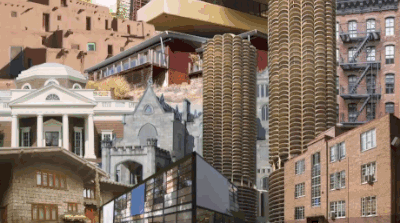
|
|
One of the 10 Buildings that Changed America: H.H. Richardson’s Trinity Church in Boston.
|
It’s easy to take the American architectural cannon for granted. These are the structures that loom large, turning points in architectural history that also have a fixed place in pop culture. But how often does the public stop to consider why these well-known monuments were once revolutionary or reflect on how they shaped American culture? In the new PBS program 10 Buildings That Changed America, which premieres May 12, writer-producer Dan Protess attempts to spark discussions about some of America’s most recognized structures and raise questions about their legacies.
Hosted by Geoffrey Baer, the show takes us on a brief tour of 10 “influential American buildings that changed the way we live, work, and play.” The one-hour journey is presented chronologically, beginning with Thomas Jefferson’s Virginia State Capitol in Richmond (1788) and concluding with Frank Gehry’s Walt Disney Concert Hall in Los Angeles (2003). Along the way, we make stops at H.H. Richardson’s Trinity Church in Boston (1877) and two skyscrapers more than half a century apart (Louis Sullivan’s 1891 Wainwright Building in St. Louis and Mies van der Rohe’s 1958 Seagram Building in New York). We also visit Frank Lloyd Wright’s Robie House in Chicago (1910), Albert Kahn's Highland Park Ford Plant in Michigan (1910), Victor Gruen’s Southdale Center in Edina, Minnesota (1956), Eero Saarinen’s Dulles International Airport (1962), and Robert Venturi’s house for his mother, Vanna Venturi, in Philadelphia (1964).
The show packs a surprising amount of material (archival images, interviews with architects and historians, assorted factoids) into its brief segments. Yet with only about six minutes allotted per building, it has the feel of a bullet-pointed overview of architecture in America. Architects will find some of the presentations superficial, but everyone else will have a lot to chew on.
Regardless of expertise, viewers will find themselves challenging this list. For its part, the show mounts a solid defense, usually beginning with an “it was the first” statement and ending with the building’s influence on the nation’s architecture and design. Most of the narratives are standards—the Robie House paved the way for the ranch home (and countless Brady Bunch-style suburban nightmares), while the Seagram Building’s elegance led to numerous soulless copycats—but the show leaves room for disagreement. In fact, one of its great assets is that it invites an argument.
Television doesn’t often take up ideas about architectural history, yet 10 Buildings provokes a critical assessment of not just these specific examples but also the houses, developments, factories, and skyscrapers that they inspired and that we encounter every day. Whatever the value of the cannon it presents, the show promises to create a public platform for a bigger debate about building in America.


Post a comment to this article
Report Abusive Comment